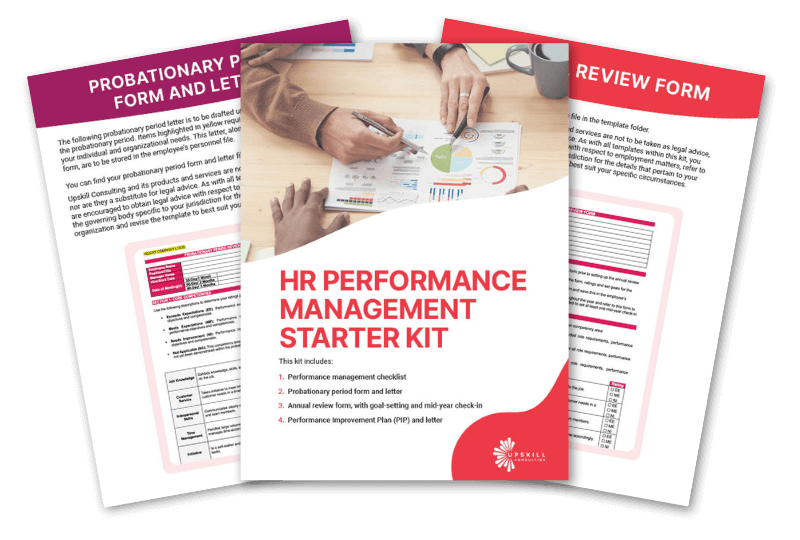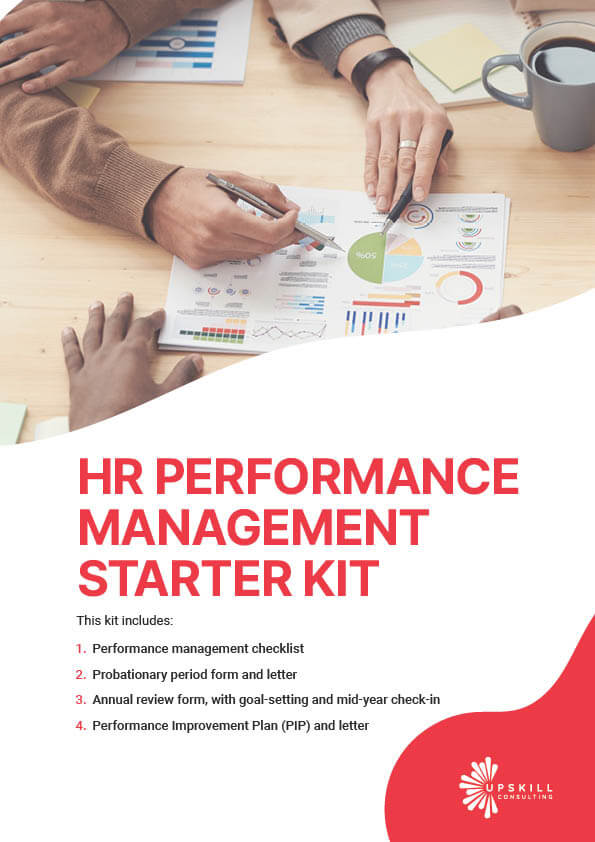As your business expands, so does the complexity of managing HR processes and practices. It’s a common scenario, and we understand the challenges you face in ensuring performance excellence within your team. That’s precisely why our Performance Management Starter Kit comes into play – equipping you with the tools to lay a solid foundation for your HR practices while ensuring compliance checkboxes are ticked.
What’s Inside the Performance Management Kit?
- Performance Management Checklist
- Probationary Period Form and Letter
- Annual Review Form with Goal-Setting and Mid-Year Check-In
- Performance Improvement Plan (PIP) and Letter
The Power of a Performance Management Checklist
Implementing a performance management checklist offers numerous benefits:
- Consistency: Standardized processes ensure every employee undergoes a consistent performance management journey.
- Efficiency: Streamlined tasks reduce administrative burdens, ensuring timely completion and minimizing the risk of oversights.
- Compliance: Address legal and regulatory requirements systematically, reducing the risk of non-compliance with legal obligations.
- Accountability: Foster a sense of accountability among all involved in the performance management cycle, aiding in progress tracking and corrective actions.
- Documentation: Follow the checklist tasks to establish a clear audit trail of performance-related decisions, maintaining comprehensive records.
The Importance of a Probationary Period
A probationary period serves as a vital trial phase for both employer and employee. Our kit provides:
- A structured form for periodic evaluations at 30, 60, and 90 days.
- A customizable letter for successfully completing the probationary period.
Annual Reviews Made Simple
Our kit includes an annual review form template, promoting regular performance discussions throughout the year. The one-hour session prompts assessment of job performance, strengths, areas for improvement, and career development.
Navigating Performance Challenges with PIP
A Performance Improvement Plan (PIP) is a proactive tool for addressing ongoing performance problems. Our kit includes:
- A PIP template outlining performance issues, expectations, action steps, and timelines.
- A letter to issue to the employee, promoting a constructive approach to skill enhancement.
Performance Management Best Practices Explored
As your business navigates the complexities of performance management, it’s crucial to not only have the right tools but also to implement best practices that foster growth and success. Here are key best practices to complement our Performance Management Starter Kit.
Best Practices for Probationary Periods
- Incorporate into Contracts: Outline the probationary period in employment contracts or offer letters, specifying its length and any specific conditions to be met.
- Clear Expectations: Clearly communicate expectations and competency areas, adjusting the form to meet your organizational needs.
- Monitor Progress: Regularly monitor performance at 30-day, 60-day, and 90-day intervals. Offer training and support to help new hires meet performance expectations.
- Objective Assessment: Remain objective and fair, assessing performance based on set criteria and observable behaviors.
- Document Performance Issues: Document performance issues and formal reviews, ensuring termination during the probationary period is conducted in good faith and non-discriminatory.
Best Practices for Annual Reviews
- Reflect and Rate: Reflect on performance and rate accordingly per competency. Consider incorporating a self-assessment component where employees can rate themselves.
- Adapt to Organizational Needs: Add or modify competencies based on organizational needs and performance measures.
- Clear Ratings and Reasoning: Be clear on your ratings and relay reasoning in the annual review meeting.
- Frequent Check-Ins: Set frequent check-ins throughout the year to monitor progress towards goals.
- Objective Assessment: Remain objective and fair, assessing performance strictly on set criteria and observable behaviors.
- Encourage SMART Goals: Encourage SMART goal setting to ensure robust and aligned goals at the company, department, and individual levels.
- Document Thoroughly: Document annual reviews and check-ins in the employee’s personnel file for future reference.
Best Practices for Performance Improvement Plans (PIPs)
- Preparation is Key: Prepare for the PIP meeting by reviewing notes, conversations, and relevant material in advance.
- Clear Communication: Clearly communicate performance issues to the employee, citing specific examples.
- Establish Clear Action Plan: Establish a clear action plan for improvement with the employee during the PIP meeting, ensuring clear and agreed-upon objectives.
- Set Follow-Up Meetings: Set follow-up performance meetings to monitor progress and performance.
- Thorough Documentation: Document all meetings, conversations, and the Performance Improvement Plan, placing them in the employee’s personnel file.
By integrating these best practices, you not only ensure compliance but also cultivate an environment of continuous improvement and success.
Get Started Today with our Performance Management Kit!
Ready to elevate your business through effective performance management? Explore our Performance Management Starter Kit https://upskillconsulting.ca/performance-management-starter-kit/, and empower your team for success. Let’s turn your HR challenges into opportunities for growth!

- Trust First, Feedback Second: Why Connection Comes Before Correction - June 1, 2025
- The Not-So-Fluffy Truth About Connection in Leadership - May 2, 2025
- Small Changes, Big Impact: The Case for Micro Shifts in Leadership - April 7, 2025

